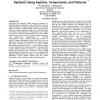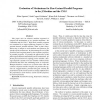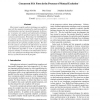APSEC
1995
IEEE
14 years 11 months ago
1995
IEEE
Guaranteeiq reproducibility and minimizing probe effects are major issues in the parallel program debugging. This paper suggests a new debugging method, named Detect and Reproduce...
ISHPC
2000
Springer
14 years 11 months ago
2000
Springer
The shared-memory programming model is a very effective way to achieve parallelism on shared memory parallel computers. As great progress was made in hardware and software technolo...
AOSD
2007
ACM
14 years 11 months ago
2007
ACM
Developing and debugging parallel programs particularly for distributed memory architectures is still a difficult task. The most popular approach to developing parallel programs f...
ISCA
1993
IEEE
14 years 11 months ago
1993
IEEE
er uses an abstract machine approach to compare the mechanisms of two parallel machines: the J-Machine and the CM-5. High-level parallel programs are translated by a single optimi...
HPCN
1997
Springer
14 years 11 months ago
1997
Springer
The performance attained by parallel programs executed on multiprocessor systems is largely in uenced both by the characteristics of the code and by those of the system architectu...
IPPS
1998
IEEE
14 years 11 months ago
1998
IEEE
Predicting the running time of a parallel program is useful for determining the optimal values for the parameters of the implementation and the optimal mapping of data on processo...
IPPS
1998
IEEE
14 years 11 months ago
1998
IEEE
The use of the DEEP development environment to analyze parallel program performance is described. The full integrated environment contains tools for the creation, analysis and deb...
ICPP
1998
IEEE
14 years 11 months ago
1998
IEEE
Most current compiler analysis techniques are unable to cope with the semantics introduced by explicit parallel and synchronization constructs in parallel programs. In this paper ...
IPPS
1999
IEEE
1999
IEEE
Visualization and Performance Prediction of Multithreaded Solaris Programs by Tracing Kernel Threads
14 years 11 months ago
Efficient performance tuning of parallel programs is often hard. We present a performance prediction and visualization tool called VPPB. Based on a monitored uni-processor executi...
PARELEC
2002
IEEE
15 years 10 days ago
2002
IEEE
Integration of P-GRADE with Condor and parallel check-pointing results in an environment under which both interactive parallel program development and batch mode execution is poss...



